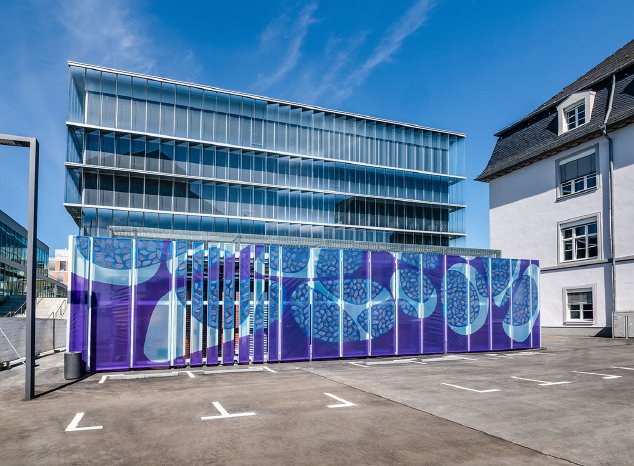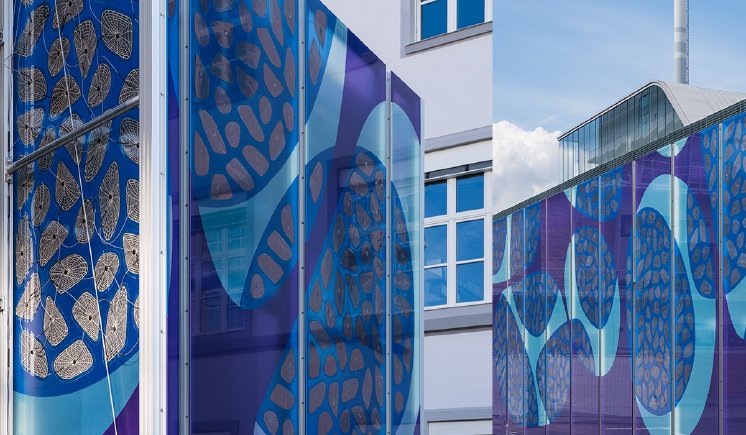The intention was to create an extravagant façade equipped with an OPV system that is appealing not only in terms of functionality but also design. OPVIUS took up this challenge and implemented it as part of the rebuilding work on the premises of Merck KGaA in Darmstadt.
From the very beginning, OPVIUS planned the implementation with an ETFE-based membrane façade. It was intended to demonstrate that printed organic photovoltaics make a fundamental contribution to the generation of energy and, therefore, to the energy efficiency of buildings, especially in combination with membrane architecture. Owing to their low weight and the associated savings in resources, membranes are becoming increasingly important as a roofing and façade material in construction. However, this is counteracted by the steadily growing demand to put building surfaces - especially roofs - to photovoltaic use. On the other hand, the integration of classic PV and membrane works only to a very limited extent. This challenge can usually be solved by the elimination of lightweight construction and the simultaneous use of classic modules. Nevertheless, the sustainability of such solutions is difficult to assess, as the benefits of PV - in contrast to membrane architecture - are achieved by high use of material in the construction of the building.
In order to overcome this restriction and come up with a suitable solution, OPVIUS and Taiyo Europe joined forces. The ETFE specialist Taiyo Europe has been building high-quality membrane architecture and ETFE structures for decades, setting new aesthetic standards time and again. The transparent, UV and weather-resistant polymer, ETFE (ethylene tetrafluoroethylene), is one of the most respected and valued products in the international field of membrane construction. It is extremely resistant to ageing and very durable and therefore very popular in the area of roofing and façades, especially in large-scale projects, such as stadiums or airports. References include the Chambourcy Mall, the Office of Waste Management in Munich, and the US Embassy in London.
With the solution presented in Darmstadt, the long-standing desire to use photovoltaic energy as an energy-generating technology in membrane constructions has been achieved. OPVIUS shows a fully integrated OPV module, including bonding to ETFE, connection technology, and all system components. In compliance with the technical and design specifications from the field of membrane construction and architecture, an aesthetically as well as a technically high-quality solution for an energy-efficient membrane façade was made available for the first time. This represents a milestone in the field of membrane construction.
The façade and module design was implemented with complete freedom of design, in accordance with the specifications of the client, Merck KGaA, incorporating the company's corporate identity, and with the involvement of the architects and designers. It was possible to implement all design specifications without compromising functionality by the use of OPVIUS manufacturing technology, which is based on a combination of printing, coating and laser technologies.
Using the OPV modules, integrated into the Taiyo colour-printed, translucent ETFE films, it was possible to build an aesthetically appealing and trendsetting façade.
"Today, we are proud to be able to offer this product as an internationally usable product to our partners, architects, designers and draftspersons in the field of façades", states Hermann Issa, Senior Director Business Development and Sales, OPVIUS GmbH. He adds "This enables the formation of entirely new concepts in membrane construction." Mr Peter Kastner, Sales Manager at Taiyo Europe GmbH adds: "The cooperation between ETFE and OPV was a real meeting of minds. It is an ideal material combination for an original and trendsetting architecture for façades and roofs."


